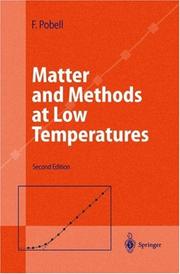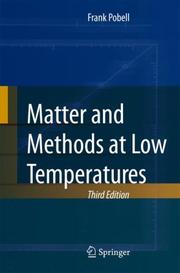| Listing 1 - 5 of 5 |
Sort by
|

ISBN: 3540585729 3662032252 Year: 1996 Publisher: Berlin : Springer-Verlag,
Abstract | Keywords | Export | Availability | Bookmark
 Loading...
Loading...Choose an application
- Reference Manager
- EndNote
- RefWorks (Direct export to RefWorks)
Cryostats --- Low temperatures --- Matter --- Basses températures --- Matière --- Thermal properties --- Propriétés thermiques --- 538.9 --- -536.48 --- Atoms --- Dynamics --- Gravitation --- Physics --- Substance (Philosophy) --- Cryogenics --- Low temperature physics --- Temperatures, Low --- Temperature --- Cold --- Cryostat --- Low temperature engineering --- Physics of condensed matter (in liquid state and solid state) --- Low-temperature phenomena. Production of low temperatures --- Equipment and supplies --- 536.48 Low-temperature phenomena. Production of low temperatures --- 538.9 Physics of condensed matter (in liquid state and solid state) --- Basses températures --- Matière --- Propriétés thermiques --- 536.48
Book
ISBN: 3319311484 3319311506 Year: 2016 Publisher: Cham : Springer International Publishing : Imprint: Springer,
Abstract | Keywords | Export | Availability | Bookmark
 Loading...
Loading...Choose an application
- Reference Manager
- EndNote
- RefWorks (Direct export to RefWorks)
This book enables the reader to learn the fundamental and applied aspects of practical cryostat design by examining previous design choices and resulting cryostat performance. Through a series of extended case studies the book presents an overview of existing cryostat design covering a wide range of cryostat types and applications, including the magnet cryostats that comprise the majority of the Large Hadron Collider at CERN, space-borne cryostats containing sensors operating below 1 K, and large cryogenic liquid storage vessels. It starts with an introductory section on the principles of cryostat design including practical data and equations. This section is followed by a series of case studies on existing cryostats, describing the specific requirements of the cryostat, the challenges involved and the design choices made along with the resulting performance of the cryostat. The cryostat examples used in the studies are chosen to cover a broad range of cryostat applications and the authors of each case are leading experts in the field, most of whom participated in the design of the cryostats being described. The concluding chapter offers an overview of lessons learned and summarises some key hints and tips for practical cryostat design. The book will help the reader to expand their knowledge of many disciplines required for good cryostat design, including the cryogenic properties of materials, heat transfer and thermal insulation, instrumentation, safety, structures and seals.
Physics. --- Particle acceleration. --- Low temperature physics. --- Low temperatures. --- Thermodynamics. --- Heat engineering. --- Heat transfer. --- Mass transfer. --- Engineering design. --- Low Temperature Physics. --- Engineering Design. --- Engineering Thermodynamics, Heat and Mass Transfer. --- Particle Acceleration and Detection, Beam Physics. --- Cryostats. --- Cryostat --- Low temperature engineering --- Equipment and supplies --- Engineering. --- Particles (Nuclear physics) --- Acceleration (Mechanics) --- Nuclear physics --- Construction --- Industrial arts --- Technology --- Design, Engineering --- Engineering --- Industrial design --- Strains and stresses --- Acceleration --- Design --- Mass transport (Physics) --- Thermodynamics --- Transport theory --- Heat transfer --- Thermal transfer --- Transmission of heat --- Energy transfer --- Heat --- Mechanical engineering --- Chemistry, Physical and theoretical --- Dynamics --- Mechanics --- Physics --- Heat-engines --- Quantum theory --- Cryogenics --- Low temperature physics --- Temperatures, Low --- Temperature --- Cold

ISBN: 3540463607 3540463569 Year: 2007 Publisher: Berlin, Heidelberg : Springer Berlin Heidelberg : Imprint: Springer,
Abstract | Keywords | Export | Availability | Bookmark
 Loading...
Loading...Choose an application
- Reference Manager
- EndNote
- RefWorks (Direct export to RefWorks)
Matter and Methods at Low Temperatures contains a wealth of information essential for successful experiments at low temperatures, which makes it suitable as a reference and textbook. The first chapters describe the low-temperature properties of liquid and solid matter, including liquid helium. The major part of the book is devoted to refrigeration techniques and the physics on which they rely, the definition of temperature, thermometry, and a variety of design and construction techniques. The lively style and practical basis of this text make it easy to read and particularly useful to anyone beginning research in low-temperature physics. Low-temperature scientists will find it of great value due to its extensive compilation of materials data and relevant new results on refrigeration, thermometry, and materials properties. Problems are included as well. Furthermore, this third edition also describes newly developed low-temperature experimentation techniques and new materials properties; it also contains many additional references and a list of suppliers of cryogenic equipment.
Matter --- Low temperatures. --- Cryostats. --- Thermal properties. --- Cryostat --- Low temperature engineering --- Cryogenics --- Low temperature physics --- Temperatures, Low --- Temperature --- Cold --- Atoms --- Dynamics --- Gravitation --- Physics --- Substance (Philosophy) --- Equipment and supplies --- Engineering. --- Thermodynamics. --- Condensed Matter Physics. --- Engineering, general. --- Solid State Physics. --- Spectroscopy and Microscopy. --- Chemistry, Physical and theoretical --- Mechanics --- Heat --- Heat-engines --- Quantum theory --- Construction --- Industrial arts --- Technology --- Condensed matter. --- Solid state physics. --- Spectroscopy. --- Microscopy. --- Analysis, Microscopic --- Light microscopy --- Micrographic analysis --- Microscope and microscopy --- Microscopic analysis --- Optical microscopy --- Optics --- Analysis, Spectrum --- Spectra --- Spectrochemical analysis --- Spectrochemistry --- Spectrometry --- Spectroscopy --- Chemistry, Analytic --- Interferometry --- Radiation --- Wave-motion, Theory of --- Absorption spectra --- Light --- Spectroscope --- Solids --- Condensed materials --- Condensed media --- Condensed phase --- Materials, Condensed --- Media, Condensed --- Phase, Condensed --- Liquids --- Qualitative --- Analytical chemistry --- Spectrum analysis.
Book
ISBN: 303655226X 3036552251 Year: 2022 Publisher: MDPI - Multidisciplinary Digital Publishing Institute
Abstract | Keywords | Export | Availability | Bookmark
 Loading...
Loading...Choose an application
- Reference Manager
- EndNote
- RefWorks (Direct export to RefWorks)
The first detection on Earth of a gravitational wave signal from the coalescence of a binary black hole system in 2015 established a new era in astronomy, allowing the scientific community to observe the Universe with a new form of radiation for the first time. More than five years later, many more gravitational wave signals have been detected, including the first binary neutron star coalescence in coincidence with a gamma ray burst and a kilonova observation. The field of gravitational wave astronomy is rapidly evolving, making it difficult to keep up with the pace of new detector designs, discoveries, and astrophysical results. This Special Issue is, therefore, intended as a review of the current status and future directions of the field from the perspective of detector technology, data analysis, and the astrophysical implications of these discoveries. Rather than presenting new results, the articles collected in this issue will serve as a reference and an introduction to the field. This Special Issue will include reviews of the basic properties of gravitational wave signals; the detectors that are currently operating and the main sources of noise that limit their sensitivity; planned upgrades of the detectors in the short and long term; spaceborne detectors; a data analysis of the gravitational wave detector output focusing on the main classes of detected and expected signals; and implications of the current and future discoveries on our understanding of astrophysics and cosmology.
Research & information: general --- Physics --- LIGO --- Virgo --- KAGRA --- gravitational waves --- detector characterization --- data quality --- noise mitigation --- seismic noise --- Newtonian noise --- seismic isolation system --- noise subtraction --- DECIGO --- thermal noise --- quantum noise --- diffraction loss --- interferometers --- ground based gravitational-wave detector --- Advanced Virgo --- gravitational-wave backgrounds --- stochastic gravitational-wave backgrounds --- stochastic searches of gravitational waves --- gravitational-wave laser interferometers --- pulsar timing arrays --- gravitational wave detectors --- optomechanics --- low-noise high-power laser interferometry --- calibration --- interferometer --- gravitational wave --- astrophysics --- laser metrology --- squeezed states --- quantum optics --- gravitational wave detector --- laser interferometer --- cryogenics --- underground --- einstein telescope --- newtonian noise --- coating noise --- silicon --- suspensions --- payload --- cryostat --- core-collapse supernova --- future detectors --- continuous gravitational waves --- neutron stars --- dark matter --- gravitational-wave astrophysics --- stars --- black holes --- stellar evolution --- binary stars --- stellar dynamics --- laser interferometers --- n/a
Book
ISBN: 3030570312 3030570304 Year: 2021 Publisher: Springer Nature
Abstract | Keywords | Export | Availability | Bookmark
 Loading...
Loading...Choose an application
- Reference Manager
- EndNote
- RefWorks (Direct export to RefWorks)
The use of non-standard technologies such as superconductivity, cryogenics and radiofrequency pose challenges for the safe operation of accelerator facilities that cannot be addressed using only best practice from occupational safety in conventional industry. This book introduces readers to different occupational safety issues at accelerator facilities and is directed to managers, scientists, technical personnel and students working at current or future accelerator facilities. While the focus is on occupational safety – how to protect the people working at these facilities – the book also touches on “machine safety” – how to prevent accelerators from doing structural damage to themselves. This open access book offers a first introduction to safety at accelerator facilities. Presenting an overview of the safety-related aspects of the specific technologies employed in particle accelerators, it highlights the potential hazards at such facilities and current prevention and protection measures. It closes with a review of safety management and organization at accelerator facilities. .
Particle acceleration. --- Physical measurements. --- Measurement . --- Quality control. --- Reliability. --- Industrial safety. --- Low temperature physics. --- Low temperatures. --- Particle Acceleration and Detection, Beam Physics. --- Measurement Science and Instrumentation. --- Quality Control, Reliability, Safety and Risk. --- Low Temperature Physics. --- Cryogenics --- Low temperature physics --- Temperatures, Low --- Temperature --- Cold --- Industrial accidents --- Industries --- Job safety --- Occupational hazards, Prevention of --- Occupational health and safety --- Occupational safety and health --- Prevention of industrial accidents --- Prevention of occupational hazards --- Safety, Industrial --- Safety engineering --- Safety measures --- Safety of workers --- Accidents --- System safety --- Dependability --- Trustworthiness --- Conduct of life --- Factory management --- Industrial engineering --- Reliability (Engineering) --- Sampling (Statistics) --- Standardization --- Quality assurance --- Quality of products --- Measuring --- Mensuration --- Mathematics --- Technology --- Metrology --- Physical measurements --- Measurements, Physical --- Mathematical physics --- Measurement --- Particles (Nuclear physics) --- Acceleration (Mechanics) --- Nuclear physics --- Prevention --- Acceleration --- Particle Acceleration and Detection, Beam Physics --- Measurement Science and Instrumentation --- Quality Control, Reliability, Safety and Risk --- Low Temperature Physics --- Accelerator Physics --- Industrial and Production Engineering --- Radiation safety --- Hierarchy of safety measures --- Accelerator operation --- Laser safety --- Ionising radiation --- Superconducting radio frequency --- Superconducting magnet --- Cryostat Design --- Open access --- Particle & high-energy physics --- Scientific standards, measurement etc --- Reliability engineering --- Measurement.
| Listing 1 - 5 of 5 |
Sort by
|

 Search
Search Feedback
Feedback About UniCat
About UniCat  Help
Help News
News